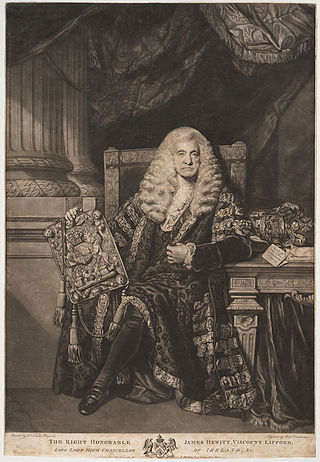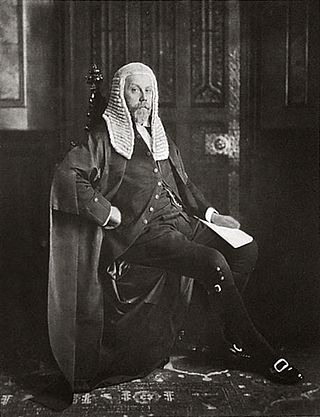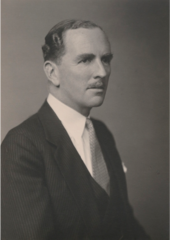Arms
|
Viscount Stuart of Findhorn, of Findhorn in the County of Moray, is a title in the Peerage of the United Kingdom. [1] It was created on 20 November 1959 for the Conservative politician the Hon. James Stuart after his retirement from the House of Commons. Stuart was the third son of Morton Gray Stuart, 17th Earl of Moray (see Earl of Moray for earlier history of the family). As of 2017 [update] the title is held by his grandson, the third Viscount, who succeeded his father in 1999.
The heir presumptive is the present holder's half-brother, the Hon. Andrew Moray Stuart (born 1957). There are no other heirs to the title.
|
This article needs additional citations for verification .(January 2021) |

Marquess Townshend is a title in the Peerage of Great Britain held by the Townshend family of Raynham Hall in Norfolk. The title was created in 1787 for George Townshend, 4th Viscount Townshend.

The title Earl of Moray, Mormaer of Moray or King of Moray was originally held by the rulers of the Province of Moray, which existed from the 10th century with varying degrees of independence from the Kingdom of Alba to the south. Until 1130 the status of Moray's rulers was ambiguous and they were described in some sources as "mormaers", in others as "Kings of Moray", and in others as "Kings of Alba". The position was suppressed by David I of Scotland some time after his defeat of Óengus of Moray at the Battle of Stracathro in 1130, but was recreated as a feudal earldom by Robert the Bruce and granted to Thomas Randolph, 1st Earl of Moray in 1312.

Earl of Radnor, in the County of Wiltshire, is a title which has been created twice. It was first created in the Peerage of England in 1679 for John Robartes, 2nd Baron Robartes, a notable political figure of the reign of Charles II. The earldom was created for a second time in the Peerage of Great Britain in 1765 when William Bouverie, 2nd Viscount Folkestone, was made Earl of Radnor.

Viscount Falmouth is a title that has been created twice, first in the Peerage of England, and then in the Peerage of Great Britain. The first creation came in the Peerage of England in 1674 for George FitzRoy, an illegitimate son of King Charles II by Barbara Villiers. He was created Earl of Northumberland at the same time and in 1683 he was made Duke of Northumberland. However, he left no heirs, so the titles became extinct at his death in 1716.

Lord Gray is a title in the Peerage of Scotland. The Barony of Gray was created circa July 1445 for the Scottish diplomat and politician Sir Andrew Gray. The first Lord Gray was a hostage in England for the good conduct of James I of Scotland from 1424 to 1427, and was one of the knights who accompanied Lady Margaret Stewart to France for her marriage to Louis XI of France in 1436.

Earl of Listowel is a title in the Peerage of Ireland. It was created in 1822 for William Hare, 1st Viscount Ennismore and Listowel, who had earlier represented Cork City and Athy in the Irish House of Commons.

Earl of Caledon, of Caledon in the County of Tyrone, is a title in the Peerage of Ireland. It was created in 1800 for James Alexander, 1st Viscount Caledon. He was a merchant who had made an enormous fortune in India. He also represented the constituency of Londonderry City in the Irish House of Commons. Alexander had already been created Baron Caledon in 1790 and Viscount Caledon, of Caledon in the County of Tyrone, in 1797, also in the Peerage of Ireland. In 1784, James Alexander purchased a city house in Dublin at Rutland Square where he lived when serving as an MP for Derry.

Earl of Wharncliffe, in the West Riding of the County of York, is a title in the Peerage of the United Kingdom.

Earl Granville is a title that has been created twice, once in the Peerage of Great Britain and once in the Peerage of the United Kingdom. It is now held by members of the Leveson-Gower family.

Earl Beatty is a title in the Peerage of the United Kingdom. It was created in 1919 for the prominent naval commander Admiral of the Fleet Sir David Beatty. He was created Baron Beatty, of the North Sea and of Brooksby in the County of Leicester, and Viscount Borodale, of Wexford in the County of Wexford, at the same time, also in the Peerage of the United Kingdom. The latter title is used as a courtesy title for the Earl's eldest son and heir apparent. Lord Beatty was succeeded by his eldest son, the second Earl. He represented Peckham in the House of Commons as a Conservative from 1931 to 1936 and briefly served as Under-Secretary of State for Air in Winston Churchill's 1945 caretaker government. As of 2014 the titles are held by his eldest son, the third Earl, who succeeded in 1972.

Viscount Lifford is a title in the Peerage of Ireland. It was created in 1781 for James Hewitt, 1st Baron Lifford, the Lord Chancellor of Ireland. He had already been created Baron Lifford, of Lifford in the County of Donegal, in 1768, also in the Peerage of Ireland. He was succeeded by his son, the second Viscount, who was Dean of Armagh from 1796 to 1830. His grandson, the fourth Viscount, sat in the House of Lords as an Irish Representative Peer from 1856 to 1887. His younger son, the sixth Viscount, was a captain in the Royal Navy. His son, the seventh Viscount, fought in both the Second Boer War and the First World War. He was succeeded by his cousin, the eighth Viscount. He was the son of the Hon. George Wyldbore Hewitt, seventh son of the fourth Viscount. As of 2014 the titles are held by his son, the ninth Viscount, who succeeded in 1987.

Viscount Monck, of Ballytrammon in the County of Wexford, is a title in the Peerage of Ireland. It was created in 1801 for Charles Monck, 1st Baron Monck. He had already been created Baron Monck, of Ballytrammon in the County of Wexford, in 1797, also in the Peerage of Ireland. His eldest son, the second Viscount, was in 1822 created Earl of Rathdowne in the Peerage of Ireland. However, this title became extinct on his death, while he was succeeded in the other titles by his younger brother, the third Viscount. The latter's son, the fourth Viscount, served as the 1st Governor General of Canada. In 1866, he was given the title Baron Monck, of Ballytrammon in the County of Wexford, in the Peerage of the United Kingdom. This title gave the viscounts a seat in the Westminster House of Lords until the passing of the House of Lords Act 1999. As of 2012 the titles are held by his great-great-grandson, the seventh Viscount, who succeeded his father in 1982. He does not use his titles.

Viscount Ullswater, of Campsea Ashe in the County of Suffolk, is a title in the Peerage of the United Kingdom. It was created in 1921 for James Lowther upon his retirement as Speaker of the House of Commons. He was the eldest son of the Hon. William Lowther, third son of the Hon. Henry Lowther, second son of William Lowther, 1st Earl of Lonsdale. The first Viscount lived to the age of 93, and was pre-deceased by both his eldest son the Hon. Christopher Lowther, a Conservative politician, and his eldest son's eldest son John Arthur Lowther (1910–1942), the title being inherited by his seven-year-old great-grandson, the second and current Viscount, in an extremely rare instance of a great-grandson succeeding his great-grandfather in a peerage. The second Viscount held office in the Conservative administrations of Margaret Thatcher and John Major and since 2003 he has been one of the ninety elected hereditary peers that remain in the House of Lords after the passing of the House of Lords Act 1999.

Viscount Bridgeman, of Leigh in the County of Shropshire, is a title in the Peerage of the United Kingdom. It was created in 1929 for the Conservative politician William Bridgeman, who had previously served as Home Secretary and First Lord of the Admiralty. He was the son of Reverend John Robert Orlando Bridgeman, third son of George Bridgeman, 2nd Earl of Bradford. His son, the second Viscount, served as Lord Lieutenant of Shropshire from 1951 to 1969. As of 2014 the title is held by the latter's nephew, the third Viscount, who succeeded in 1982. He is one of the ninety elected hereditary peers that remain in the House of Lords after the passing of the House of Lords Act 1999, and sits as a Conservative.

Baron Harmsworth, of Egham in the County of Surrey, is a title in the Peerage of the United Kingdom. It was created in 1939 for the Liberal politician Cecil Harmsworth, Under-Secretary of State for Foreign Affairs between 1919 and 1922. As of 2017 the title is held by his grandson, the third Baron, who succeeded his uncle in 1990.
Baron Catto, of Cairncatto in the County of Aberdeen, is a title in the peerage of the United Kingdom. The only hereditary peerage newly conferred during the reign of King Edward VIII, the barony was created on 24 February 1936 for the businessman, banker and public servant, Sir Thomas Catto, 1st Baronet. He had already been created a baronet, of Peterhead, on 5 July 1921. As of 2018 the titles are held by his grandson, the third baron, who succeeded his father in 2001.
Baron Ravensdale, of Ravensdale in the County of Derby, is a title in the Peerage of the United Kingdom.

Earl Stanhope was a title in the Peerage of Great Britain. The earldom was created in 1718 for Major General James Stanhope, a principal minister of King George I, with remainder to the heirs male of his body. He was the son of the Hon. Alexander Stanhope, fifth and youngest son of Philip Stanhope, 1st Earl of Chesterfield. In 1717, James Stanhope had been raised to the peerage as Viscount Stanhope, of Mahón in the Island of Minorca, and Baron Stanhope, of Elvaston in the County of Derby, with special remainder, failing heirs male of his body, to his second cousin John Stanhope of Elvaston and the heirs male of his body. These titles were also in the Peerage of Great Britain. The heir apparent of the Earls Stanhope used Viscount Mahon as a courtesy title.

James Gray Stuart, 1st Viscount Stuart of Findhorn, was a British Unionist politician. He was joint-Parliamentary Secretary to the Treasury in Winston Churchill's war-time coalition government and later served as Secretary of State for Scotland under Churchill and then Sir Anthony Eden from 1951 to 1957. In 1959 he was elevated to the peerage as Viscount Stuart of Findhorn.

Earl of Carrick, in the barony of Iffa and Offa East, County Tipperary, is a title in the Peerage of Ireland.